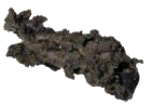We
know lightning to be the electrical charge occurring in stormy
weather. Most of us have seen it, and it can be very
intimidating, especially when associated with crackling thunder and
pounding rain. Aside from the storm at hand, when conditions are
right, something extraordinary may also occur as a result of
lightning. In the twinkling of an eye, fulgurites can be created
by the effect of lightning striking silica sand (SiO2), and fusing it
into a tube-like shape. The name Fulgurite, pronounced ful’-gu-rite, is from the Latin: Fulgur (lightning). Wikipedia’s definition is as follows: “Fulgurites are natural hollow carrot-shaped glass tubes formed in sandy soil by lightning strikes. They are up to a couple centimeters in diameter, and can be meters long if they are carefully excavated so as not to break the fragile structure. The interior is normally very smooth or lined with fine bubbles; the exterior is generally coated with rough sand particles. They are rootlike in appearance and often show branching or small holes.”1 I think you would agree that these are most definitely a product of very strange phenomena. About 100 lightning discharges occur every second on the Earth, on average. Only about one-third of them involve ground strikes which have the potential to make fulgurites. The earliest discovery of a fulgurite was reportedly made in 1706 by Pastor David Hermann in Germany. All fulgurites can be divided in two classes: sand fulgurites and rock fulgurites. Sand fulgurites are usually hollow, glass-lined tubes with sand adhering to the outside. Rock fulgurites are formed when lightning strikes the bare surface of rocks and gives the appearance of a thin glassy substance encrusted on the rock. Glass of this type displays a wide range of colors, depending on the composition of the host rock.2The
peak temperature of a lightning channel is approximately 50,000
degrees Fahrenheit,
five times higher than the surface temperature of the Sun, and
considerably higher than silica's (Si02) melting point of 2950 degrees
Fahrenheit.3 When lightning strikes sandy soil, the air and moisture present
in the soil are rapidly heated, and the resultant explosion-like
expansion forms the central tubular void of the fulgurite. Relatively rapid cooling then causes the glass to solidify.
A general condition for a sand fulgurite formation is the
presence of a relatively dry dielectric such as quartz sand overlying
a more conducting soil layer. The result is a natural glass sculpture whose shape mimics the
path taken underground by the lightning bolt as it dissipates in the
earth. 2 The
diameter of most fulgurites range from a quarter of an inch to 3
inches, and anything larger is very unusual. However, one find near Gainesville, Florida, in 1996 led to
many days of careful digging and resulted in the unearthing of a
fulgurite having two mostly vertical branches, one about 16 feet and
the other about 17 feet long. It
was recognized by the Guinness Book of Records as the world's longest
excavated fulgurite. Mr.
Martin Uman, a member of the research team, states, "If a normal
citizen tries to dig one of these out of the ground, they would
destroy it because fulgurites are so fragile. It takes experts who are skilled in working with special tools
and are used to digging up fossil bones. It's definitely an art."2 Fulgurites’
glassy color ranges from pale gray, to smoky gray, to shiny black,
depending upon the type of sand from which they were formed. Since fulgurites are real glass, weathering has little effect
on them, and they can be well preserved for a long period of time, and
they are used as paleo-environmental indicators. For example, many fulgurites are found in the Sahara, where
currently there is little lightning activity, so we can assume that
very different conditions existed there in prehistoric times. It was in this place that a fossil fulgurite thought to be 250
million years old has been reported.2 -------------------------------------------------------------------------- References: 1.
Wikipedia, the Free Encyclopedia. <http://en.wikipedia.org/wiki/Fulgurite> 2.
Vladimir A. Rakov. “Lightning Makes Glass.” 29th
Annual Conference of the Glass Art Society, Tampa, Florida, 1999. <http://plaza.ufl.edu/rakov/Gas.html> 3.
Mineralogical Research Company. “Fulgurites –
Products of Lightning.” <http://www.minresco.com/fulgurites/fulgurites.htm> 4.
Hidden Universe. “Fulgurite.” <http://blueorgone.com/Fulgurite.html> 5.
CFMS Newsletter – February 2003. <http://www.cfmsinc.org/Newsletter/News2003/002Feb03/newsfeb03.htm
> 6.
Glossary of Geology, Third Edition.
American Geological Institute, 1987.
Picture
from http://perso.wanadoo.fr/carion.mineraux/fulgurites2.htm |
